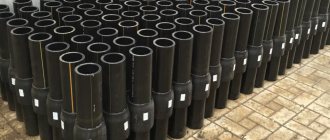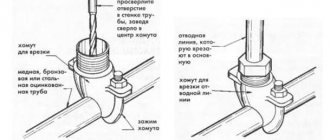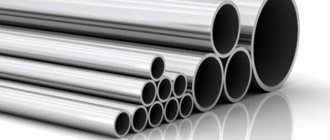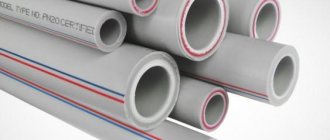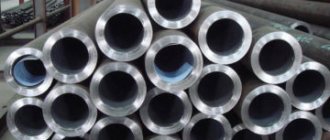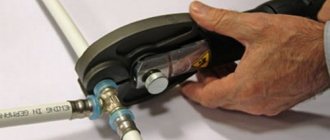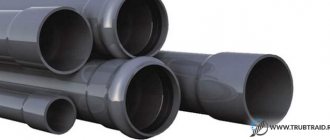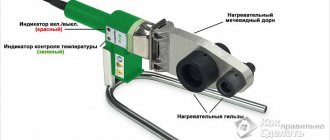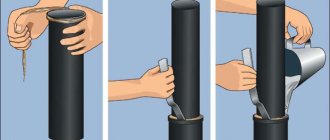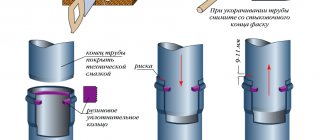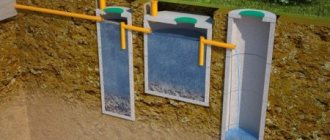When installing pipelines, welding is most often used to connect individual elements. But sometimes it is necessary to make the connection dismountable or to join elements made of different materials. In this case, a flanged pipe connection can be used. Let's figure out how it's done.
Flange connections are used when installing large-diameter pipelines, since the flanges used for joining parts are quite bulky and heavy. There are several types of flange connections, but they are all made in accordance with GOST requirements. Let's figure out which connection options using flanges are most often used.
general description
To connect two pipes, flanges are used, which are a flat ring (the flange can have another shape, for example, a square frame). In the center of the part there is a hole into which the end of the pipe is inserted.
Along the contour of the “frame” there is an even number of mounting holes intended for installing fasteners. Bolts or studs with nuts can be used for fastening.
When using flanges, the joints are detachable. In order to make the connection airtight, sealing gaskets are installed. Flanges are used to connect pipes to each other, as well as when connecting a pipe to a container that has an inlet pipe to which a flange is welded.
Thread diameter
- All threaded fasteners have an internal (nuts) and an external (studs and bolts) thread diameter. Depending on the purpose and the regulatory document according to which the product is manufactured, the thread can be metric or inch. Metric thread pitch is measured in millimeters, and inch thread pitch is measured in inches.
- Thread pitch is the distance between two adjacent thread tips.
- Depending on the purpose of the fastener, most regulatory documents provide for the possibility of manufacturing fasteners with different thread pitches (large or fine thread pitch). As a rule, the coarse thread pitch is the main one and is not indicated when ordering the product.
- In some cases, a thread pitch may be made that differs from that recommended by regulatory documents.
- The turnkey size is equal to the diameter of the inscribed circle.
- As a rule, one turnkey value is provided for each nominal thread diameter.
- Bolt length - the length indicated in the product designation when ordering, in most cases is not a dimensional characteristic. Mostly, the length of the bolt indicated in the product designation is equal to the length of the bolt shank, i.e. the height of the bolt head is not taken into account.
- Example: for a bolt M12x120 - the length of the bolt shaft is 120 mm, while the total overall length is greater by the height of the bolt head by 7.5 mm, i.e. the total overall length is 127.5 mm. In Fig. 3: l - bolt length; l+ k = overall overall length of the bolt.
Stud length
- For most studs, the length l specified when ordering indicates the overall overall length of the stud. However, some regulatory documents do not include the entire length of the stud in the designation of studs.
- Example: GOST 22032-76, which applies to studs with a screw-in end of length dv, provides for the designation of the length of the stud, which does not include the length of the screw-in end. l is the length of the pin, b is the length of the screwed end (Fig. 4).
Version 1
- The thread tolerance field indicates the accuracy of the thread.
- The larger the tolerance field value, the greater the deviation of the thread parameters from the nominal ones.
- For most fasteners, a sufficient thread tolerance zone for external threads is 6d, for internal threads—6H.
- Threaded end length is the length of the part of a bolt or stud designed to screw on a nut.
Manufacturing materials and types
To connect metal pipes, flanges made of the following materials can be used:
- Gray cast iron. Parts are made by casting. The use of these parts is permitted at operating pressures up to 16 MPa. The temperature of the transported medium must be in the range from -15 to +300.
- Cast iron is malleable. Parts are manufactured by casting. It is allowed to be used for installation of pipelines with a working pressure of up to 4 MPa, but the operating temperature range is wider - from -30 to +400.
- Steel. Cast steel flanges can be used to connect pipes made of different materials. The maximum operating pressure is up to 20 MPa, the temperature range is very wide - from -250 to +600 degrees.
- Steel. Welded flanges are used for assembling pipelines operating at low pressure - up to 2.5 MPa.
Advice! For the manufacture of flanges, different types of steel are used - alloy, carbon, stainless.
Relatively recently, flanges made of polymer material began to be used. Polypropylene parts are used on plastic pipelines operating without pressure (or with low pressure). Depending on the purpose, there are two types of flanges:
- Walkthroughs. They are used to connect the pipe to other parts of the pipeline.
- Deaf. Installed in dead-end branches of the highway.
Types of flanges
A large number of designs of this part have been developed for process pipelines. All flange connections consist of the following elements - flanges, gaskets, fasteners. The main task assigned to this unit is to combine parts of the pipeline or connect additional equipment to the pipes. Flanges are divided into types depending on various parameters. By design they are divided into:
- solid;
- free.
The difference is that solid flanges, together with the body, undergo correspondingly the same loads.
They are made together with fittings during the process of casting or stamping, and the combination can also be done by welding. As for free ones, they are a disk that is attached to a welded flange or flanged edge of the pipe. Both types have both disadvantages and advantages. Loose flanges are easy to assemble and their design makes it easy to align the holes for the studs. The disadvantage is less strength and rigidity than solid flanges. Separation of flanges by purpose:
- For fittings and pipelines. Flange connections of pipelines of this type are used for all types and industries of pipe, transport and housing and communal services.
- For vessels and apparatus, such connections are used for oil distillation, equipment for heat supply systems, as well as storage tanks.
Principle
To connect pipes with flanges, it is necessary that fasteners be installed at the ends of both parts being connected. Moreover, these parts must be identical, otherwise it will be impossible to make a hermetically sealed connection between the parts.
Advice! Flanges installed at the ends of the parts to be welded are called counter flanges.
The flange is attached to the end of the pipe in one of two ways:
- on thread (applicable only for non-pressure pipelines);
- by welding.
After both counter flanges are installed, they are connected and tightened using fasteners.
Advice! A stud, unlike a bolt, does not have a head. The thread is cut on the stud on both sides. Thanks to this, when making a connection, you can tighten the flanges on both sides by screwing the nuts onto both sides of the stud.
Constructive.
The basis of this group of characteristics is the flange design. In the Russian Federation and CIS countries, three flange standards are most widespread:
- GOST 12820-80 - steel flat welded flange.
- GOST 12821-80 - steel butt welding flange.
- GOST 12822-80 - loose steel flange on a welded ring.
Flanges according to the three most common standards mentioned above are designed to connect pipeline fittings and equipment. Due to their design features, the installation conditions for these flanges vary.
- Flat welded steel flange. During installation, the flange is “slipped” onto the pipe and welded with two welds around the circumference of the pipe.
- Butt welded steel flange. Installation of such a flange, compared to a flat welded flange, requires only one connecting weld (in this case, it is necessary to butt the end of the pipe and the “collar” of the flange), which simplifies the work and reduces time costs.
- Steel loose flange on weld ring
In addition, it is positive that when selecting free flanges for a stainless steel pipe, for the sake of economy, it is allowed to use a stainless steel ring and a carbon flange (Table 1).consists of two parts - a flange and a ring. In this case, naturally, the flange and ring must be of the same nominal diameter and pressure. Such flanges differ from the above in ease of installation, since only the ring is welded to the pipe, and the flange itself remains free, which ensures easy joining of the bolt holes of the free flange with the bolt holes of the flange of the fittings or equipment without turning the pipe. They are often used when installing pipeline fittings and equipment in hard-to-reach places or when frequently repairing (checking) flange connections (for example, in the chemical industry).
| Flange type | Environment Settings | Material grade | |
| Conditional pressure Ru, kg/cm2 | Temperature K (°C) | Flange | |
| Steel flat welded GOST 12820-80 | from 1 to 25 | from -30 to 300 | St3sp not lower than 2nd category according to GOST 535-88 |
| from -70 to 300 | 09G2S according to GOST 19281-89, 10G2 according to GOST 4543-71 | ||
| from -30 to 300 | Steel 20, 25 according to GOST 1050-88 | ||
| from -40 to 300 | 15ХМ according to GOST 4543-71 | ||
| from -40 to 300 | 12Х18H9Т according to GOST 7769-82 | ||
| Steel butt weld GOST 12821-80 | from 1 to 25 | from -30 to 300 | St3sp not lower than 2nd category according to GOST 535-88 |
| from 1 to 100 | from -40 to 425 | Steel 20, 25 according to GOST 1050-88 | |
| from 1 to 200 | from -30 to 450 | ||
| from -40 to 450 | 15ХМ according to GOST 4543-71 | ||
| from -40 to 300 | 5Х18Н12С4ТУ (type) GOST 5632-72 | ||
| from -70 to 300 | |||
| from -70 to 350 | 09G2S according to GOSTG2 according to GOST 4543-71 | ||
| from -40 to 400 | 06ХН28МДТ (type EI-945) according to GOST 5632-72 | ||
| from -70 to 400 | |||
| from -40 to 450 | 12Х18Р9Т 10Х17Н13М3Т (type EI-432) according to GOST 5632-72 | ||
| from -40 to 510 | 15Х5М according to GOST 5632-72 | ||
| from -80 to 600 | 12Х18Н9Т according to GOST 5632-72 | ||
| from -253 to 600 | 10Х17Н13М3Т (type EI-432) according to GOST 5632-72 | ||
| Steel free on a welded ring GOST 12822-80 | from 1 to 25 | from -30 to 300 | St3sp not lower than 2nd category according to GOST 535-88 |
- In addition to these three standards, special mention should be made of flanges manufactured according to customer drawings (non-standard flanges). Unlike the first three flanges mentioned above, this design is not permanent and can be changed depending on the client's expectations and requirements. Such flanges are individual and serve to meet any customer needs.
- Flanges manufactured according to foreign standards differ structurally from Russian ones. Among imported ones, the most widely used in Russia are flanges made according to German DIN standards (a standard accepted throughout Europe) and American ANSI.
| Distinctive characteristics of flanges | |
| Constructive | Technological |
| Nominal diameter DN | |
| Conditional pressure Ru | |
| Version 1 to 9 | |
| Row 1 or 2 | |
| Round (square) | |
| Material | Art. 20 |
| Art. 09G2S | |
| Art. 15X5M | |
| Art. 08Х18Н10Т (12Х18Н10Т) | |
| Other | |
| Design | Steel flat welded flanges GOST 12820-80 |
| Butt welded steel flanges GOST 12821-80 | |
| Steel free on a welded ring GOST 12822-80 | |
| Foreign standard | |
| Non-standard | |
| Flanges according to other Russian standards |
Flanges according to other Russian standards include the following: threaded steel flanges, flanges of vessels and apparatus, insulating flanges for underwater pipelines. They differ from the above in design and applications.
Design features also include (using the example of the three most common GOSTs):
- Conditional pass. It is designated as DN and measured in mm.
- Conditional pressure. It is designated as Ru and measured in kgf/cm2.
- Designs 1 to 9. Determines the type of surface for the gasket.
- Material (represented by Russian steel grades).
Choice
Like any other fittings used to assemble pipelines, flanges are available in different sizes. Let's figure out what characteristics you need to pay attention to.
Conditional passage
This is a very important characteristic. The nominal diameter of the flange is, in fact, the internal diameter of the pipe on which this part is installed. This parameter is designated by the letter DN and measured in mm. For welded flanges, a Latin letter is indicated along with the nominal diameter; the letter indicates the outer diameter of the pipe.
Row
Parts that have the same nominal diameter are not always the same. Another important parameter is rowing. Model differences:
- in the difference between the center distances of the mounting holes;
- diameter of mounting holes.
Operating pressure
When choosing fittings, it is very important to pay attention to such an indicator as the working pressure in the pipeline. This indicator is determined by the maximum possible pressure at which the pipeline can operate without leaks at the dismountable joints. Conditional pressure indicators depend on the following parameters:
- geometric dimensions of parts;
- material of manufacture;
- presence and material of the sealing gasket.
Working temperature
This indicator is no less important, since if the maximum values are exceeded, a leak may form at the flange connections. The parameters of operating pressure and operating temperature depend on each other, therefore these indicators are indicated in special tables in the accompanying documentation for the product.
What is a counter flange?
A flange means a fastener that provides fastening of parts of pipes, pipes to fittings, pumps, facilitating maintenance of pipeline sections. Depending on the operating conditions, rotary, transition, rubber-coated or counter flanges are used. Technical characteristics, standard sizes, conditions of use of a specific flange are regulated by a specific GOST.
The flange part has a paired delivery set, consisting of direct flanges and counter flanges (counter flanges). The counter steel flange is a counter connection element, manufactured differently from the main product. The variation of the counterflange is determined by the type of flange connection and the technical parameters necessary for its correct operation. Mating steel flanges are divided into the following subtypes:
- products with smooth joints that do not include a groove for the gasket. Such counter flanges are used when the pressure inside the pipeline is low;
- products designed for high pressure conditions. A counter flange of this subtype is used when installing pipelines with maximum internal pressure;
- products made using a recess for gaskets. Such fasteners guarantee additional sealing of the pipeline system.
Special valves are also used as a shut-off device on cold (hot) pipelines. A wedge flanged valve is attached to fittings using flanges and is often used in pipelines transporting aggressive compounds, some petroleum products, steam, water, and ammonia. Ball valves are also widely used in pipeline fittings. According to the type of connection, ball valves are divided into types: flanged, coupling and welded.
Gasket selection
Gaskets must be used to seal the connection. It is especially important to correctly calculate the degree of sealing when operating a pipeline under pressure. The choice of material for the manufacture of gaskets depends on the operating conditions and the properties of the transported medium. Most often used:
- Rubber. Depending on the properties of the environment, a material is selected that is resistant to acids and alkalis, oil and petroleum products, and temperature.
- Paronitis. General purpose or oil resistant material can be used.
- Fluoroplastic.
- Asbestos cardboard.
The gasket is cut to the shape of the flange; its thickness depends on the selected material.
How is the connection made?
The most important point of installation is tightening the flange connection. It is important to achieve maximum sealing of the joint.
Preparatory stage
First of all, you need to inspect the connecting surfaces of the flanges; there should be no noticeable defects in the form of potholes and scratches. There should be no traces of corrosion.
Advice! It is necessary to inspect not only the flanges themselves for defects, but also the fasteners - bolts (studs) and nuts.
It is recommended to first “run” the nuts along the bolt threads to make sure that there are no defects on the threads. Next you need to install the new gasket, making sure that it is positioned correctly.
It is not recommended to install the old gasket during disassembly and subsequent reassembly. As a last resort, it is permissible to install 2-3 used gaskets, provided that they do not have obvious damage.
How is tightening done?
To ensure even tightening, the bolts must be tightened in a specific sequence. It is recommended to do the work like this:
- the first bolt (any) is lightly screwed on;
- the second one tightens (also lightly) the bolt located opposite the first one;
- the third bolt, which should be slightly tightened, is located at an angle of about 90 degrees with respect to the first and second;
- The fourth bolt to work with is opposite the third.
Thus, if a flange with four holes is used, then the bolts are tightened using the “crosswise” principle. If a part with six holes is used, then the first four bolts are tightened in the same way, then work with the fifth bolt located between the first and third, and the last bolt located between the second and fourth is tightened.
Having completed this stage, they begin to gradually tighten the bolts in the same sequence. To ensure a tight connection, the bolts must be tightened with a certain force.
If you overdo it, you can break the thread, and if the tightening is uneven, you won’t be able to achieve a tight seal. To ensure uniform tightening force, use special devices:
- torque wrench - manual or hydraulic;
- pneumatic impact wrench;
- tensioning mechanism with hydraulic drive.
After starting the pipeline, during the first day of operation it is possible to loosen the tightening within 10%. Therefore, on the second day after starting the system, it is necessary to further tighten the connections.
So, flanges can be used to create a collapsible pipeline connection. Despite the relative ease of making flange connections, installation work should only be performed by specialists. Especially if connections are made on pipelines for transporting hazardous media (for example, domestic gas). Work on pressure pipelines and flange connections are carried out under the supervision of engineers.
Flange fastener
To install flange connections, fasteners are required. The following fasteners are used for fastening pipelines: bolt, nut, stud and washer. Since flange connections of pipelines are a rather critical design, requirements are imposed on fasteners in accordance with the following parameters:
- Wednesday. She may or may not be aggressive. Based on this environmental parameter, fasteners are selected. For aggressive environments, preference is given to steel with anti-corrosion properties. It is also possible to use special coatings that prevent corrosion.
- Temperature. The temperature of the liquid or gas that will be transported through this pipeline, as well as the temperature regime of the environment, plays a role here. Each material has an operating temperature range, according to which the product is selected. If the environment does not exceed –30 ºС, it is possible to use conventional steel grades; for lower temperatures, cold-resistant grades are used.
- Pressure. The higher the operating pressure, the higher the parameters of the material used to make the studs for flange connections.
- Indicators of fasteners: thread type, pitch, length.
- Material. Steel used in the production of fasteners for flange connections can be classified into four categories:
- general purpose carbon steel, operating temperature should not exceed 200 ºС, and maximum diameter – 48 mm;
- carbon steel used for high-precision products, operating temperature cannot be higher than 300 ºС;
- carbon steel of improved quality, fasteners made of this material can be used at temperatures above 450 ºС;
- alloy steels, which have heat-resistant and anti-corrosion properties.
